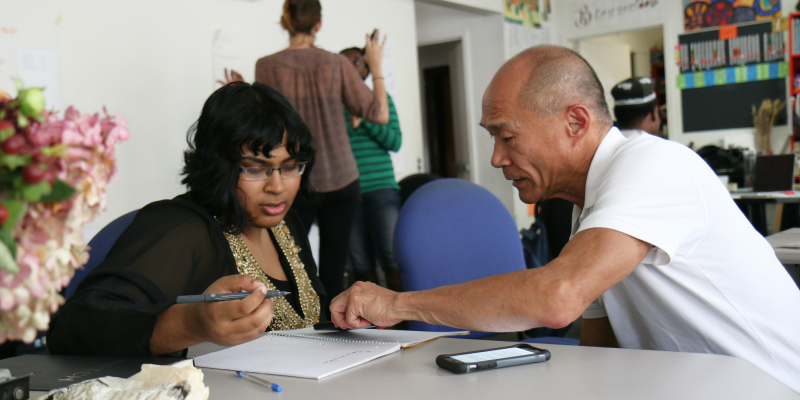Transforming SNAP access through technology and empathy

By Cara Karter | August 3rd, 2022 | 6 minute read

Key Takeaways
- Community-based SNAP outreach is vital to closing the participation gap
- Individuals most in need often face the biggest barriers to accessing benefits
- Policy changes are needed to support SNAP outreach technology and reach those unable to visit a local office
“I froze; I was afraid I was telling God that [by applying for SNAP] I didn't trust Him to provide for my family.”
SNAP is our government’s most potent and effective anti-hunger tool. Yet, 7.8 million SNAP-eligible Americans are trying to feed their families without it. At mRelief, we believe the solution to increasing access to SNAP’s life-saving benefits should prioritize two strategies. First, investing in community-based outreach services that provide individuals with culturally-relevant, empathetic support. Second, eliminating transaction costs by offering transparency and leveraging technology.
Enabling community-based outreach
The COVID-19 pandemic forced many innovations in the SNAP policy and outreach space. Notably, many state agencies and local community-based SNAP outreach providers shifted to providing application and case support over the phone to all clients. This created a need for technology and policy flexibilities to enable remote outreach and assistance.
To meet this demand, mRelief developed an accessible platform for outreach workers to reliably connect with clients both over the phone and in-person. Our client relationship management platform, Johnnie, enabled outreach workers at local food banks and community organizations to respond to the public health crisis.
Closing the gaps in benefits access
As the pandemic has evolved, it has become clear that this national crisis, and the compounding impact of historic inflation, has highlighted gaps in existing systems. According to data from the USDA Economic Research Service (2015), one-third of SNAP recipients are without access to their own transportation. A further 44% of adults in households with incomes below $30,000 don’t have broadband internet access. These gaps leave many low-income Americans, especially those who live in rural communities, without access to in-person support or to online application portals. Compounding these access issues is the complexity of program rules and enrollment processes. Research has found that households most in need also report finding the most difficulty navigating the application process.
In Georgia, our local community partner shared, “I am grateful for mRelief and the Johnnie platform for giving me the opportunity to work with the most vulnerable members of our community, and assisting them in getting the assistance they not only need but deserve.”
Addressing stigma with empathy
In Texas, Daniel, a disabled veteran, recently shared with us the anxiety he had around applying for SNAP for his young family. He said when he was filling out the application “I froze, I was afraid I was telling God that I didn't trust Him to provide for my family.” Daniel’s family, like many Americans, has struggled with the rising cost of living. “We have absolutely no money left. I applied to three jobs I was overqualified for and the only one that told me to come in…never called.” Struggling to find a job and with dried-up savings, Daniel was bearing an enormous amount of guilt around not being able to feed his family. On top of that, he struggled, like so many others, with the thought that by applying for SNAP he was taking advantage of a system meant to support others. “I don't know what to do…I didn't want to add to the cost of feeding at least 40% of the country.” Many low-income Americans, like Daniel, face damaging stigma that compounds their anxiety around seeking government assistance.
Experiences at local SNAP offices have sometimes served to reinforce negative messages around help-seeking. Research shows that people of color are more than twice as likely to report experiencing unfair treatment or judgment when applying for benefits. That is one reason why SNAP outreach services from trusted, established community organizations in local communities are so important. For Daniel, having access to an outreach specialist over the phone, who shared that he deserves to not go hungry and that this help is meant for people like him, was enough to encourage him to apply.
Simplifying enrollment with technology
Research has found that stigma is difficult to untangle from transaction costs (e.g., time, transportation, postage, and notably, frustration) in the context of benefits access. Particularly as negative enrollment experiences have been shown to contribute to stigma. However, existing evidence suggests that transaction costs likely are a larger barrier to benefits take up than is stigma. At mRelief, we believe a dual-approach — addressing stigma with information-sharing and empathy, and transaction costs with transparency and technology — is key to transforming access.
Innovating to improve outcomes
We often hear from community members who have fallen through the cracks of the current system. We recently spoke to a senior who lives alone in a mobile home in a rural area with no mail delivery, no internet access, and spotty cellular reception. He had recently applied for SNAP again after food and gas prices began to make his limited social security budget difficult to maintain. He shared that he had previously received SNAP for a while but when they called for a recertification phone interview he missed the call. While he tried to call back, they never answered. He would leave a message asking for them to call at a certain time or to text him ahead of time so he could get to a spot with good reception, but they never did. They went back and forth five times and were never able to complete the interview so the office cut his benefits. Technology has the power to transform access to SNAP and other social services. A simple solution, like offering call scheduling, could have prevented this outcome.
Advocating for supportive policies
mRelief’s products have enabled local community organizations across the United States to be responsive to the national crisis, filling in the gaps of the existing systems. However, there are still major barriers in the enrollment process for SNAP benefits, and in the fight to end hunger in America at large. In the near term, as pandemic era waivers and administrative flexibilities expire, it will be critically important for SNAP applicants nationwide to still be able to access compassionate assistance remotely.
Many states still do not allow third party providers, like mRelief and our local community partners — food banks and social service agencies — to submit electronically signed applications on behalf of clients. That means that clients who complete their application over the phone or online still need to wait to receive the application in the mail, sign it, and send it back — practically erasing the benefits of a technology based solution to SNAP enrollment. mRelief has worked with some states to negotiate for a digital signature in place of a wet signature — such as having a client type their name attesting to signing the application and sending it by text message, or prompting them to enter a unique pin onto their phone’s keypad while they’re on the phone completing the application — both methods are allowable signatures according to the Federal Food and Nutrition Service, but have not been implemented consistently.
Conclusion
The pandemic has been a case study in a more human-centered, tech-enabled safety net that helped millions of families in the US afford to eat. As the pandemic evolves, and a recession looms, supporting policies that enable continued flexibility and new innovation to reduce complexity, or enable community-based SNAP outreach to ease individuals through that complexity — both in person or over the phone — is critical in the fight to end hunger in America.
Partner with us to transform access to social services.
Reach out to us, together we can connect more Americans to life-saving benefits.